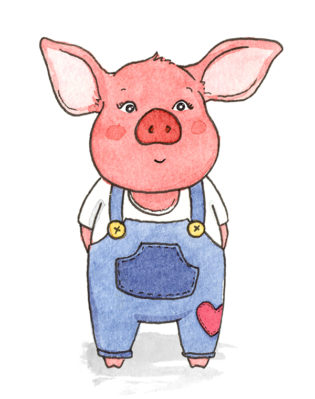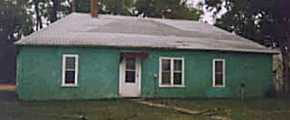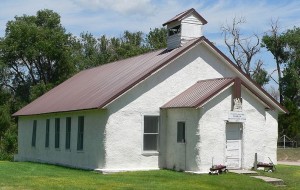If the idea of building a strawbale house makes you think of the Three Little Pigs, you might want to read the next chapter:
Everyone knows the story of the Three Little Pigs and their tragic struggle with the Big Bad Wolf but most people don’t know what happened next.
Edmund Little, the third pig little pig, was the one who built the brick house that the wolf couldn’t blow down and became a local hero. Due to the success of his wolf-proof house, everyone in his town wanted a brick house, and so he opened a company called “Mr. Little’s Brick Home Building.”

To build so many brick houses, they needed lots of bricks so they opened a big brick factory that made hundreds of brick every day. Finding clay to make the raw bricks was easy — it was almost everywhere– but they had to chop down a lot of trees to heat the kilns to cook the bricks. So they also starting a logging company to chop down trees to burn in the factory. Everyone was busy and happy chopping, burning, and building with brick.
Eventually, there were lots of brick houses and everyone felt very safe. Even though they felt happy and secure in their houses, they noticed that the world outside of their houses didn’t seem quite as nice as is used to be: the streams were dirty, the air seemed thicker and grayer than they remembered, and there weren’t as many trees as there used to be, but they told themselves that it was okay because everyone had a nice brick house.
Edmund had a daughter named Alice. Alice’s family’s brick house was the finest in the town, extremely wolf-proof and handsome. It was Alice’s job to bring in the firewood for the house and she noticed that it took a lot of wood to warm her house in the winter and that it was also uncomfortably hot in the summer. If the air outside was damp then the house felt damp and if the air was dry then the house felt dry.
When she got old enough to think about building her own house she wondered how to make it better. Maybe if it had more fireplaces to keep her warmer in the winter and a fan in every room to cool her down in the summer… Maybe she could install a network of tubes to move air around and make it drier or damper as needed… Or maybe there was a better way to build a house than to build it with brick? She asked everyone she knew if there were any other ways to build but was told, “Brick is the best way, that is how it is done.”
But she was a stubborn and independent piggy and she began to try to invent a better way of building, one that the wolves still couldn’t blow down but that worked a little better than brick and didn’t involve quite so much chopping and burning. She saw that the local farmer had lots of bales of straw left over from growing wheat, and imagined what fun it would be to just stack up all those bales like big, fuzzy blocks and put a roof on and have a house! She told her father her idea.
“You know what happened to your uncle when he built with straw,” he said gravely, “The wolf blew his house right down.”
“This is different!” she insisted, “These are big, solid, heavy blocks, not just handfuls of straw. It will be much stronger and safer than what he built.”
“Ok, if you say so, but why would you want to do something silly like that when you could have a fine brick house someday?” he asked.
Alice was not convinced. She asked the farmer if he needed all those bales and he said he would be more than happy to give her some because there wasn’t much he could do with them. He said that sometimes he had to burn the extra straw to get rid of it to make room for the next crop, which he didn’t like to do because it made the air thick and black for days.

Alice did some research and found that she was not the first to think about building with bales. When European settlers arrived on the plains of Nebraska, they found very few trees — or even rocks — to build with but they did have fancy new horse-powered baling machines and they did have a lot of grass, so they made shelters out of bales of grass. These buildings were meant to be temporary, just to get them through the harsh winter, but some of them were so stout and cozy that they became permanent. She was amazed to find that some of these buildings had survived for over a hundred years and were still standing!

While doing this research, she heard about a few modern pioneers who had been experimenting with building with bales. So she visited them. She stayed in a tiny house built with straw bales that other past visitors had helped to build and fell in love with the not-quite-flat, not-quite-square quiet coziness of it. She stayed on and helped them build more buildings and, in return, they were generous with their knowledge and she learned a great deal. She learned that building a strawbale house was not quite as simple as just stacking up the bales: that it needs a solid foundation in the ground, a nice wide roof, a thick layer of plaster to give it good pair of boots, a good hat, and a good coat. She also realized that she needed to know enough about all of the other systems — like plumbing and electricity– that go into building any house.
She came back to her hometown full of inspiration and confidence. She bought a little piece of land near her father’s house and told him she planned to build her own strawbale house. He smiled and wished her luck and then quietly began to draw up plans for a nice brick house to build for her when she gave up on this silly straw idea.
At first, Alice would go to her piece of land and just sit and look. She watched how the sun and shade moved across the land and noticed where the wind came from. When she knew her land, she planned a house that fit with the sun and the wind and the land and then she began to build. When the word got out about her project, the neighbors began to drop by with questions.
“My horses love to eat hay. Won’t the horses and goats try to eat your straw house?” one neighbor asked.
“That’s the difference between hay and straw: hay still has seeds to eat but straw is just the stem of the plant with all the food removed. There will be nothing for them to eat in my walls,” Alice said as she began to dig for the foundation.
“What if the wolf tries to burn it down when he can’t blow it down?” another neighbor asked.
“Once I have the plaster on, I’ll be safe. The plaster doesn’t let the air or the fire get to the bales, which makes the house very fire safe,” she replied, as she built the sturdy wood frame for her house. “And even if the fire somehow got through the plaster, the bales are dense like a thick book and do not burn well. I’d have time to pack my bags while he tried to get the house to burn.”
“It’s just straw, won’t it rot and fall apart like the straw bale I left in my garden last year?” asked a friend.
“Almost anything will rot if you don’t protect it. Wood will rot if you leave it out in the garden. I will give my house a good roof with wide overhangs and a thick coat of plaster and then it will not rot,” she answered while framing the roof. “In fact, the walls of my house will breathe moisture in and out naturally and won’t ever grow mold.”
“Won’t mice crawl into your walls to make nests like they do in the stacks of bales in my barn?” asked the farmer.
“They are such nice, dense bales you made and I am stacking them so tightly together that there won’t be any space for a mouse’s nest between them,” she said while she worked on her roof. “When they can’t get into my solid walls, they will give up and go back to living in your barn.”
When she had finished building the sturdy foundation and wood frame and had finished the roof so she would have a dry place to work, she went out to the farm and chose the farmer’s nicest, driest bales.
She cut the bales carefully to fit snugly around the wood frame of the house and stacked them in the same pattern as bricks. She cut channels into the straw and hired an electrician to run the electrical wires in the channels. She filled the channels and any small holes with cob, a mix made of the clay she found while digging the foundation and straw leftover from cutting bales. Then she mixed up a big batch of clay plaster and plastered the bale walls inside and out. It was hard work but she loved the smell of the straw and the feel of the clay.
The house she made was not the biggest or the fanciest but it was nice. It was warm in the winter and cool in the summer. In the winter, the low sun ducked down to kiss her windows and warm the floor and walls of the house. When she built a small fire in her fireplace, it quickly warmed the whole house and the thick, snug walls held in the precious heat.
In summer, she could open her windows and collect the cool evening breeze, then close the windows and keep that coolness inside through the next day. The hot, high summer sun couldn’t reach under the wide roof overhangs, leaving her house in the cool shade.
The clay plaster on the walls seemed almost magical: it breathed in extra moisture, making the humid days less humid and exhaled the moisture back out on dry winter days. She never saw droplets of moisture on the inside of her windows in the winter as she had in the brick house where she grew up. She loved her quiet, not-quite-flat, not-quite-square strawbale house and also loved how little chopping and burning had gone into making it.
One day a wolf came to town. The town hadn’t seen wolves in years because all of the houses were brick and the wolves knew they couldn’t blow them down, but this wolf had heard that there was a new house that wasn’t brick and he thought he might have a chance.
He approached Alice’s house and yelled, “Little pig, little pig, let me in!” Nothing happened. He yelled louder, “I’ll huff and I’ll puff and I’ll blow your house down!”
An upstairs window opened and Alice leaned out. “Oh, I’m sorry, I couldn’t really hear you inside my quiet strawbale house. What did you say?”
Angry and a little self-conscious, the wolf shouted “You know the drill! Let me in or I’ll wreck your nice house!”
“No,” she said and shut the window.
So the wolf took a huge breath and blew as hard as he could, but nothing happened. Then he backed up, ran as fast as he could and slammed into the wall. He bounced off with a bone-shaking thud but the wall was fine. By this time, all of the neighbors were watching from their windows, concerned about Alice in her strawbale house. The wolf got mad and decided to burn the house down. He gathered some sticks and paper and lit a fire right next to the wall. The fire sent black smoke up while the sticks burned and then it just went out. Other than getting a little bit of black soot on it, the wall was fine. Discouraged and embarrassed, the wolf gave up. “That house is just as strong as a brick house,” he muttered as he walked away.
That evening, the town had a huge feast to celebrate another wolf defeat and Alice got her picture in the local paper along with an article about her strawbale house.
One by one, her neighbors began to see what Alice loved about her house and started to wonder if someday they might be able to have a strawbale house of their own instead of a too-hot, too-cold, dead-flat, dead-square brick house. Eventually, Alice’s father started to get requests to build strawbale houses and asked her if she would help his company learn. She happily agreed but she did have one suggestion: “How about we rename the company Alice & Father Home Builders?” she said with a twinkle in her eye. Her father met her halfway and “Little Family Home Builders” began to build lovely strawbale homes for everyone who wanted one.
With less demand for brick, the brick factory started making solar panels as well as bricks and the logging company could slow down and plant as many trees as they cut down. Slowly, the streams and the air cleared up, the forests grew back, and the world became as nice as it used to be. And the wolves, who realized they’d never be able to catch the pigs again, learned to like tofu bacon instead.
